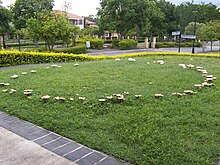
Back Heksekring Afrikaans Ведзьміны кругі Byelorussian Самодивски кръг Bulgarian Čarodějný kruh Czech Heksering Danish Hexenring German Sorĉistina ringo Esperanto Corro de brujas Spanish Seenering Estonian Maitagarrien eraztun Basque

A fairy ring, also known as fairy circle, elf circle, elf ring[1] or pixie ring, is a naturally occurring ring or arc of mushrooms.[2] They are found mainly in forested areas, but also appear in grasslands[3] or rangelands. Fairy rings are detectable by sporocarps (fungal spore pods) in rings or arcs, as well as by a necrotic zone (dead grass), or a ring of dark green grass. Fungus mycelium is present in the ring or arc underneath. The rings may grow to over 10 metres (33 ft) in diameter, and they become stable over time as the fungus grows and seeks food underground.
Fairy rings are the subject of much folklore and myth worldwide—particularly in Western Europe. They are often seen as hazardous or dangerous places, and linked with witches or the Devil in folklore. Conversely, they can sometimes be linked with good fortune.
- ^ Chambers, William; Chambers, Robert (1840-03-07). "Scheches of Superstitions: Modern Fictions of Noerthern Europe". Chambers's Edinburgh Journal. 9 (423). Edinburgh: W. Orr [etc] W. and R. Chambers: 55. hdl:2027/njp.32101064473612. OCLC 700338084.
- ^ "What is a Fungus?". Australian National Botanic Gardens.
- ^ Chisholm, Hugh, ed. (1911). . Encyclopædia Britannica. Vol. 10 (11th ed.). Cambridge University Press. p. 135.
© MMXXIII Rich X Search. We shall prevail. All rights reserved. Rich X Search